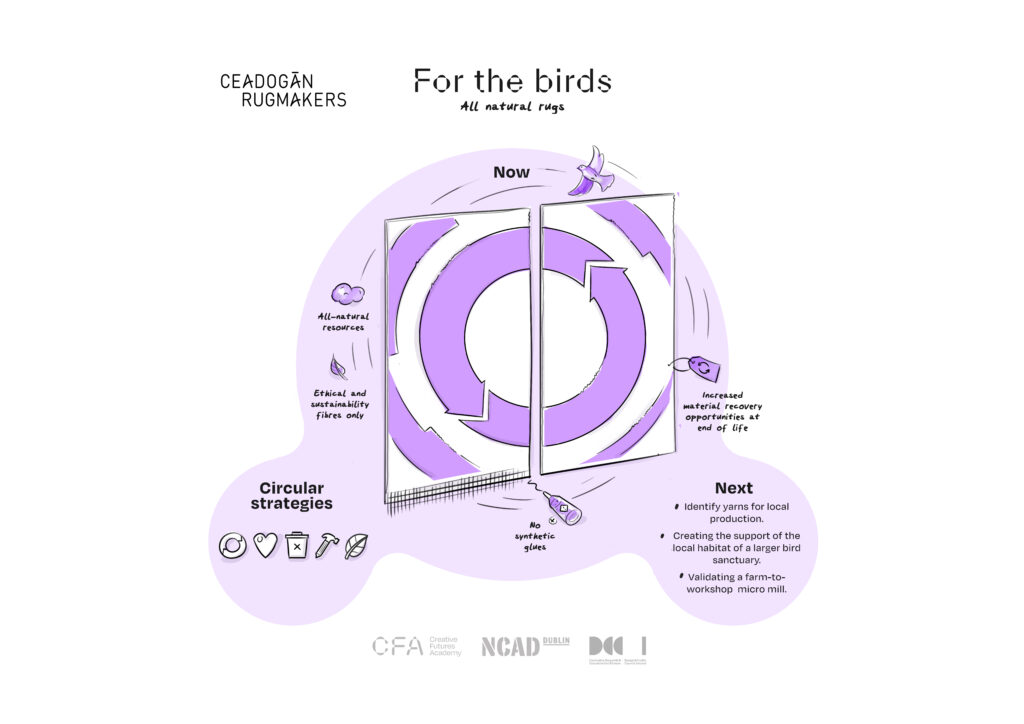At the core of “For the Birds” is a desire to weave what we do into the fabric of where we are.
We want our presence here to have a positive impact on our surroundings.
In looking at our location we have shared with you a little of what has come here before us, and what is present and sharing this space with us now, we will now take a look at our needs, and how we can work them in a positive and reciprocal way into what surrounds us for the future.
We have never been big polluters at Ceadogán, our rugs are made to last with quality materials and do not fall into the fast fashion category. It is still important to consider end of life and to ensure that disposal or re-use will not cause issues for anyone in the future.
We did not want to focus on the reduction of harmful impact to tolerable levels as a target but rather make it our mission that our activities here will have a lasting and positive effect.
By carefully examining the materials and processes we use we could ensure that our by products or “waste” would become a nutrient so to speak, much like the compost heap in your garden.
We were thrilled to be selected for the circular by design pilot project with NCAD, Creative Futures Academy and DCCI earlier in 2022 which gave us a fantastic opportunity to meet other like minded people working within the textiles community in Ireland. There is a growing network all over the world as people become more aware of the importance and urgency of change.

Circularity is the key, and an ambitious aspiration to take this concept further could be visualised in an expanding spiral being formed as the cycle grows on each revolution.
Its quite a challenge to break down every process with this objective in mind, and we don’t take it lightly. Our first task was to identify what materials we use that we might want to eliminate. One of the major problems for recycling and re use of materials is separating one material from another. Often this problem will result in perfectly good materials being unusable simply because they cannot efficiently be isolated or extracted from waste. We have been tufting for many years now using only natural yarns, mainly wool and silk.
The industry standard backing material however is polyester, and the industry standard secondary backing which binds the tufted yarn is also polyester. This would not be a problem if it were possible to efficiently remove the tufted wool at end of life but unfortunately this is not the case with a tufted rug or carpet. The second material we focused on was synthetic glue, again this is an industry standard. Sometimes this will also have fire retardants in the mix making it even more harmful and difficult to deal with. If we were to remove these two materials from the matrix of our rugs we would have something which could in theory be composted. As could all of our waste and scraps.
The polyester backing is cheap, and it functions extremely well for the process of tufting. It is also very easy to source in varying sizes. Industry standards do come about with good reason! We experimented with several natural alternatives each having their pros and cons. Our main hurdles were stretch and friction while working. We have settled on cotton, and have found that linen works well for smaller rugs. The secondary backing is an easier fix as its physical properties are not as important. We have replaced the polyester with jute and linen. We switched to natural latex as an adhesive also meaning that our rugs are now 100% natural. We were very pleased with the results and after several prototypes we felt it was time to design these into our rugs.
Our second objective was to weave all of this into our surroundings. It seemed the obvious way to do this would be to introduce a small “fibre flock” of sheep or similar or perhaps to investigate the possibility of plants for yarns. Processing would be a problem and a bridge we will cross once we have identified what fibres are best suited to our needs.

We took the opportunity to experiment with alpaca yarns and visited Loop Head Alpaca Farm in County Clare. Valerie there had three natural coloured yarns from her alpacas Donnie, Bonita, and Fudge, which we took with us. Sooo soft!! And such beautiful creatures, we almost took them home there and then.

We did some further research into plant based yarns and sourced some wool/hemp yarns which we decided to trial. Our research even lead us to Sardinia where a strong tradition of natural dying prevails on the Island. Having sourced the yarns we wished to trial we took a small pebble which we had found on the strand in Bannow Bay. We decided we would each make a design based on this stone with Martina drawing inspiration from one side, and Colm working from its flip side.
You can see the resemblances and yet they are entirely different. We have named them “Soft Landing” #1, designed by Martina and tufted in hemp/wool yarns and “Soft Landing” #2 designed by Colm and tufted in wool, silk and un dyed alpaca yarns from Donnie, Bonita and Fudge at Loop Head alpacas in Clare. We are delighted to include these in our upcoming “Island” exhibition auction.

We will include #2 in the auction which can be viewed at https://bid.whytes.ie/
The second we will raffle. Details of the raffle and how to enter will follow. These are one off pieces, and 50% of all profits will go to the Peter McVerry Trust. The remainder will go directly into getting our “For the Birds” mission off the ground. So please show your support!
